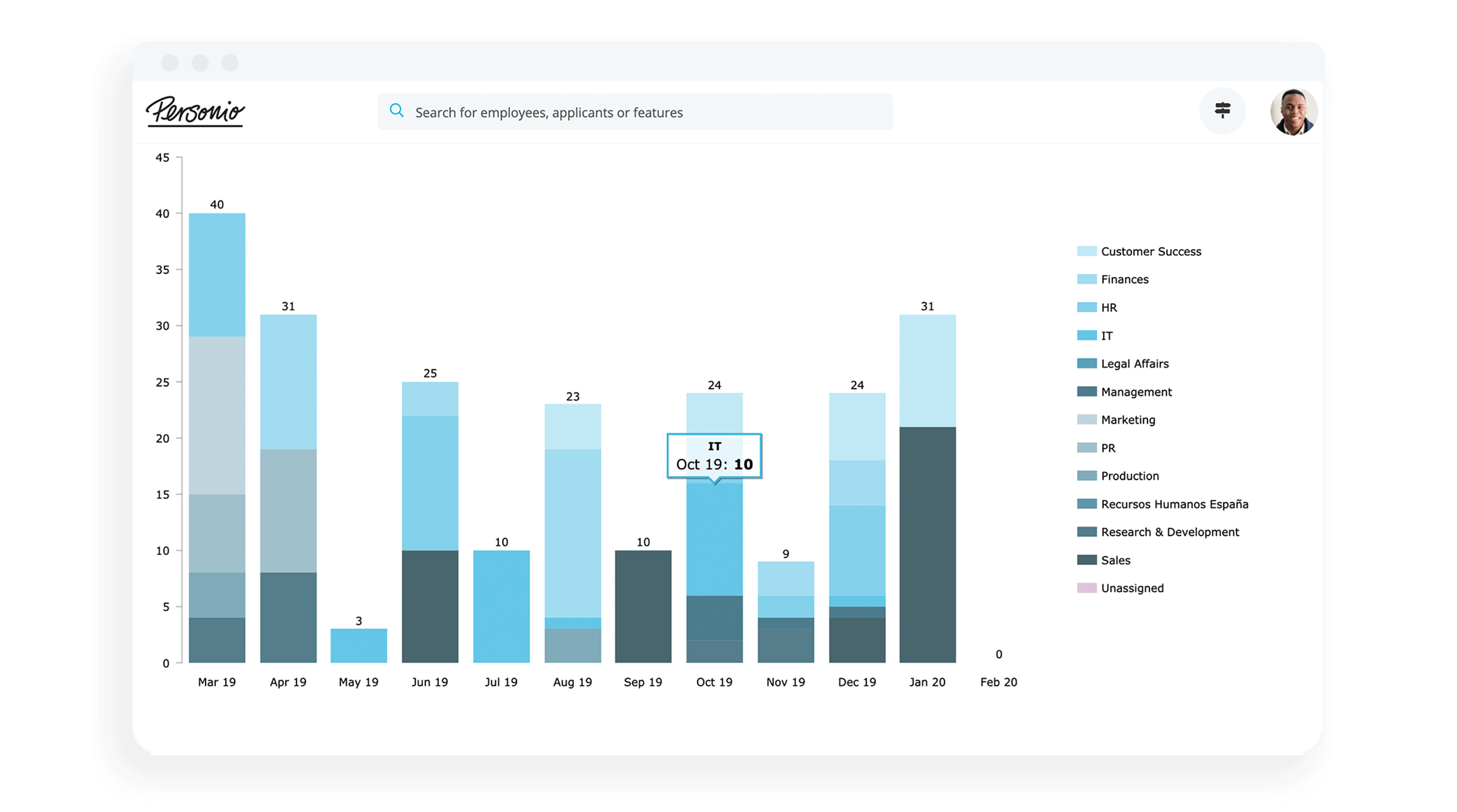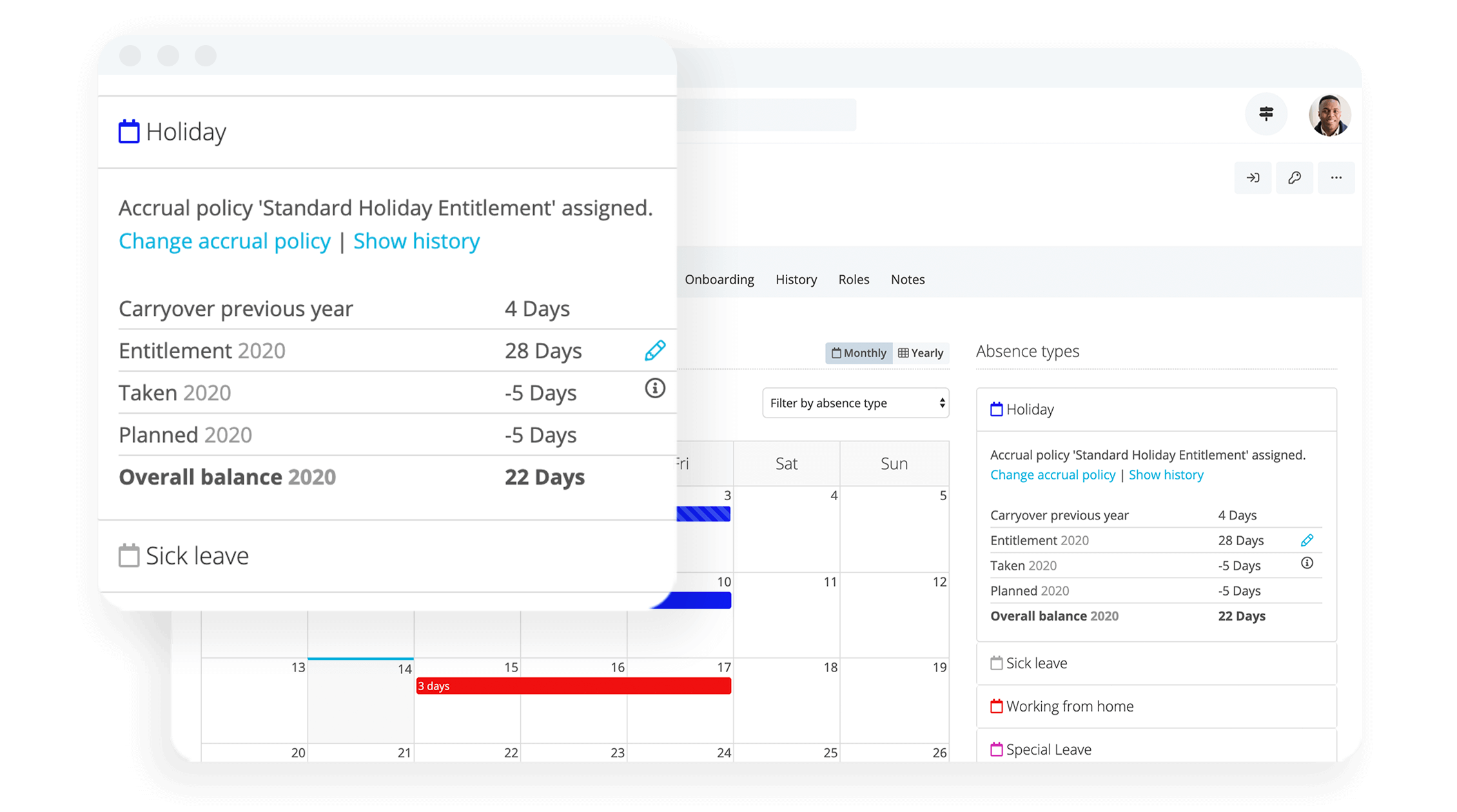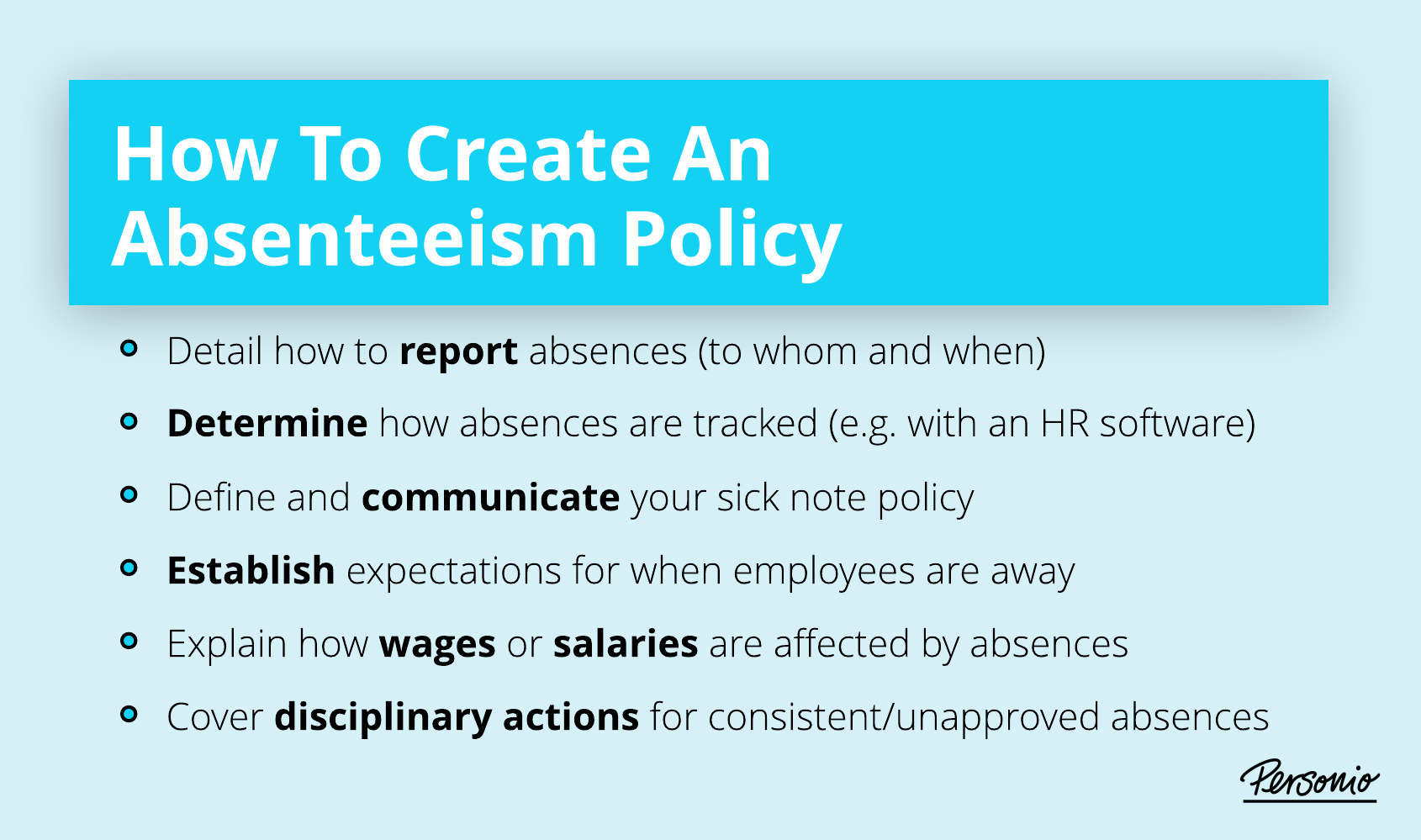
Analyse Your Absences
Instantly track availability across your organisation.
Unlock HR Analytics With PersonioLatest Blog Posts
Absenteeism in the Workplace: Causes & Solutions

Absenteeism is a stressful situation for all involved. Whether an employee is gone from work for one day or one week, their absence has a ripple effect that impacts their workload, their team, and management.
By identifying the true cause of an employee’s absence, you can get to the root of the problem, give them the support they need, and develop a plan that helps both them and the team succeed.
Optimise all your absence management processes with Personio.Contents
- 1What is absenteeism in the workplace?
- 2What are types of absenteeism?
- 3The eight primary causes of absenteeism
- 4How do you calculate absenteeism?
- 5What is an employee's 'lost time rate'?
- 6How does absenteeism affect organisation's?
- 7How do you decrease absenteeism rates?
- 8How do you create an absence policy?
What is absenteeism in the workplace?
Absenteeism is when an employee does not turn up for work consistently over a period of time with little or no explanation. The concept does not apply to things like planned time away (or PTO), various types of illness or familial emergencies.
Calculate your absenteeism rate
What is the difference between absence and absenteeism?
An absence in the workplace occurs either with good reason or advance notice. Absenteeism, on the other hand, is often unexplained or unapproved.
What are types of absenteeism?
Not all employee absences fit into the same category. If you can identify which type of absenteeism you’re dealing with, you can better establish a plan to quickly manage and correct it without issue.
Learn more about effective absence management tracking software with Personio.
Overall, there are three main types of general absenteeism in the workplace:
1. Authorised and planned absences
This includes any time off that has been arranged between the employee and their superior, such as holiday leave, appointments, personal leave, paternity or maternity leave, compassionate leave, etc.When an employee has submitted and approved their request for time off, their absence shouldn’t be an issue. With the right preparations from the employee and their team, any work and tasks can be scheduled around their approved absence accordingly.
2. Unplanned-but-genuine absences
Sometimes, though, needing a half-day, the full day, or multiple days off from work can’t be planned for. While disruptive to the workplace, unplanned, genuine absences are simply a part of life. These include illness, family emergencies, or accidents.
3. Unauthorised absences
This is where absenteeism becomes an issue. Unauthorised and disingenuous absences are often the most frustrating scenario for those who are left to pick up the absent employee’s work and manage the absence overall. Examples include participating in a work strike or choosing not to go to work without an approved or genuine reason.
Easy-to-Use Absence Management (for Everyone)

Speak with an expert about how Personio can digitise and revolutionise the way you track absences.
See It In ActionThe eight primary causes of absenteeism
Absenteeism is caused by a mix of the avoidable and unavoidable; while some causes can be improved with the help of the employee’s HR company or through team support, others are simply out of anyone’s control.
The main causes of absenteeism include:
1. Minor illness
In the UK, the average rate of absenteeism from work due to illness is 4.4 days per year, per employee. While you can’t necessarily control when you get sick, informing your superior as soon as possible can help make your absence easier to manage.
2. Workplace bullying or harassment
Workplace bullying and harassment is a prominent issue in the UK. In a 2020 survey, 23% of British workers said they’d been bullied at work, and 25% said they’d been made to feel left out.
In the workplace, specifically, bullying and harassment can include denying someone training or promotional opportunities, unfair treatment, spreading rumors, or undermining someone.
3. Mental health issues
Over 11 million workdays are lost due to employee stress, whether that stress is due to dealing with employee burnout or overwork, or due to family, financial, or personal issues. Aside from stress, mental health conditions including depression, anxiety, or other illnesses can often lead to an employee feeling unwell enough to miss work.
4. Major illness and long-term conditions
When an employee faces a major illness, they’ll typically need an extended period of time off work to recover, along with a clear return-to-work program that eases them back into their role.
When dealing with a long-term medical condition, an employee may need a customised work environment or more flexibility in their schedule to account for routine medical appointments.
5. Familial matters
While some employers encourage their employees to leave their personal issues at the door, in reality, it’s not so easy. Difficult situations and circumstances such as divorce, an urgent matter with a child’s school, a sickness in the family, or lack of childcare support can lead to emergencies that employees must leave work and tend to.
6. Approved leave
Approved leave falls under the Approved and Planned Absences category, and is often much easier to manage. This includes bereavement leave, paternity leave, maternity leave, paid holiday, etc.
7. Commuting issues
If you’re a commuter, you already know there are countless ways your daily trip to the office can go wrong. Employees can often miss hours of work due to inclement weather, delayed public transportation, construction, car trouble, or accidents.
8. Team and management issues
When an employee doesn’t respect or agree with their management team, becomes bitter after a negative interaction with leadership, or disagrees with their company’s decisions, they may disengage and skip out on work to avoid the situation or related stress.
How do you calculate absenteeism?
To calculate an employee’s absentee rate, take the number of their unexcused absences during a period of time and divide by the total period, then multiply by one hundred to get a percentage.
For example, let’s say John has three unexcused absences over the course of one month (25 workdays). To calculate his absentee rate:
Calculating Absence Rate |
|---|
3 absences over 25 working days |
3 / 25 = 0.12 |
0.12 x 100 = 12% Absentee Rate |
You can learn more about the Bradford factor by clicking here.
What is an employee's 'lost time rate'?
The time lost rate is the total work time lost due to an employee’s absences. You can use this to gain more insight into how an employee’s absences impact their work, and business performance, overall.
How do you calculate lost time rate?
To calculate an employee’s lost time rate, take their total number of absences (days/hours) and divide them by the possible work total (hours/days) in a specific period and multiply it by one hundred.
Let’s take Sarah, for example. Sarah works five days a week, every week, for a total of 25 days per month. In the last month, she’s missed four days of work. To calculate her lost time rate:
Calculating Lost Time Rate |
|---|
4 days missed over 25 days |
4 / 25 = 0.16 |
0.16 x 100 |
16% Lost Time Rate |
This tells us that 16% of Sarah’s potential time working in one month was lost due to absenteeism, which is 32 hours of work at a rate of eight hours daily.
What do you do with this information? When your HR team has more time to be strategic, they can help with calculations like this with data that is reliable and secure, at all times.
Download our guide to transforming your HR department today.
How does absenteeism affect organisation's?
The effects of employee absenteeism on the workplace are wide-ranging and potentially quite damaging in terms of productivity, finance, and overall morale. But, it is also largely dependent on the employee, their role, and the company’s size.
For example, a smaller marketing agency with one website developer will feel the impact of their absence more than a mid-to-large-size agency that has multiple website developers on staff, since they can more easily cover the absent employee’s workload.
No matter an organisation’s size, though, they’re bound to feel some effects of absenteeism, including:
Decreased productivity
One employee’s absence impacts the productivity of their entire team. Their team members will not only have to cover the absent employee’s work but then catch up on their own work later on. Meetings may have to be rescheduled, timelines will need to be adjusted, and those managing the absence will lose time overseeing it all.
Poor quality work
If you’ve ever been down a team member during a busy shift or had to cover tasks from an absent coworker, you’re familiar with the stress and pressure that puts on your own work. Employees can easily feel overwhelmed with an unexpected increase in workload, leading to poor results and potentially losing clients or customers.
Financial losses
The average cost of employee absence per year, per employee, is £522, with absenteeism estimated to cost the UK economy £21 billion in 2020.
When one employee is absent, the company then must pay for the costs of replacing that worker, the administrative costs involved, and overtime (if necessary).
Of course, the costs of missing work affect the individual employee the most, especially if they’re not on a salary and rely on commissions or tips for income.
Toxic corporate culture
Over time, habitual absences from a singular employee can create a lot of tension in the workplace. The coworkers who have been covering the workload can begin to resent the absent coworker or feel taken advantage of, and management can become stressed over the frequent absences. Absenteeism can have a massive impact on corporate culture.
Demotivated workforce
Depending on the reason for their absences, the employee’s own stress is likely to increase as well — from the cause, the missed work, and the missed paycheques. One employee’s stress can easily transfer to another, causing a breakdown in employee motivation and morale across the team.
To read more about staff attrition and why they might leave, click here.
How do you decrease absenteeism rates?
Although you can’t control many of the causes of absenteeism, there are a few actions you can take to decrease your company’s absenteeism rate and improve the employee experience overall:
1. Increase workplace flexibility
Approximately half of lone-parent families in the UK work full-time, with many struggling to maintain work-life balance. Those who regularly miss work due to issues with childcare can greatly benefit from more flexibility in their work, whether through work-from-home options, flex hours, or schedules that can be adjusted to family needs.
2. Keep morale and motivation high
While better company culture doesn’t happen overnight, incorporating health and wellness programs, personal development opportunities, workplace culture events, and initiatives focused on employee well-being have led to positive outcomes for nine out of ten organisations.
These outcomes include better morale and employee engagement, healthier workplace culture, and lower sickness absence.
3. Recognise and reward attendance
Employees that don’t feel recognised for good work are twice as likely to quit. Although the negative impacts of an absent employee are more obvious than the positive impacts of a punctual employee, recognising and rewarding those with great attendance records (aside from genuine and approved absences) can incentivise others to improve their own track records.
4. Lead by example
If your company’s leaders are often out of office at the last minute, with no reasonable excuses, it can feel like unspoken permission for employees to do the same. Hold every employee accountable for their attendance, and ensure each absence is tracked, managed, and addressed the same way.
Track attendances without worry using Personio today.
5. Train your line managers
Are your managers and supervisors prepared to deal with absenteeism? Training should include the processes and systems needed to track and manage employee absences, as well as relational training so they can navigate difficult conversations with employees in a productive manner.
6. Reach out to struggling employees
If an employee has persistent genuine absences, book a meeting to discuss the issues at the heart of those absences, as well as how they can manage and work around them. Creating a comfortable environment is especially important when dealing with sensitive issues related to health or family.
7. Conduct return-to-work (RTO) interviews
When an employee comes back to work after a prolonged period of time, arrange a return-to-work interview between them and their manager or an HR professional. A return-to-work interview can help ease an employee back into their role and give them an opportunity to discuss related issues as well as create a strategy to improve their absenteeism.
8. Consider disciplinary action
As soon as a pattern of absenteeism emerges, arrange a one-on-one meeting to discuss it with the employee and discover the root cause. If absences don’t improve, enforce your absenteeism policy (see below) and enact disciplinary action as needed, which may include dismissing an employee.
How do you create an absence policy?

Part of your company policy should include rules and regulations around employee absenteeism, including:
How to report absences (to whom and when)
How absences are tracked
The company’s sick note policy
Communication around expectations for when employees are away from work
How their wage or salary is affected by their absence
Disciplinary actions for consistent, unapproved absences
Combat absenteeism with absence management software
The world of work is only becoming more complex. The last thing you should be worrying about is calculating holiday entitlements, tracking them or ensuring you are legally compliant. Allow us to help.
Personio is an all-in-one HR software that helps upgrade your people operations for now and the future. That includes a leave management software that can manage holiday requests, track every kind of leave (from emergencies to sicknesses and bank holidays) alongside all of your other core HR processes.
8,000+ customers in the UK and Europe trust us to help. Get in touch with one of our helpful HR experts today, or start your own free trial to give Personio a go right away.

